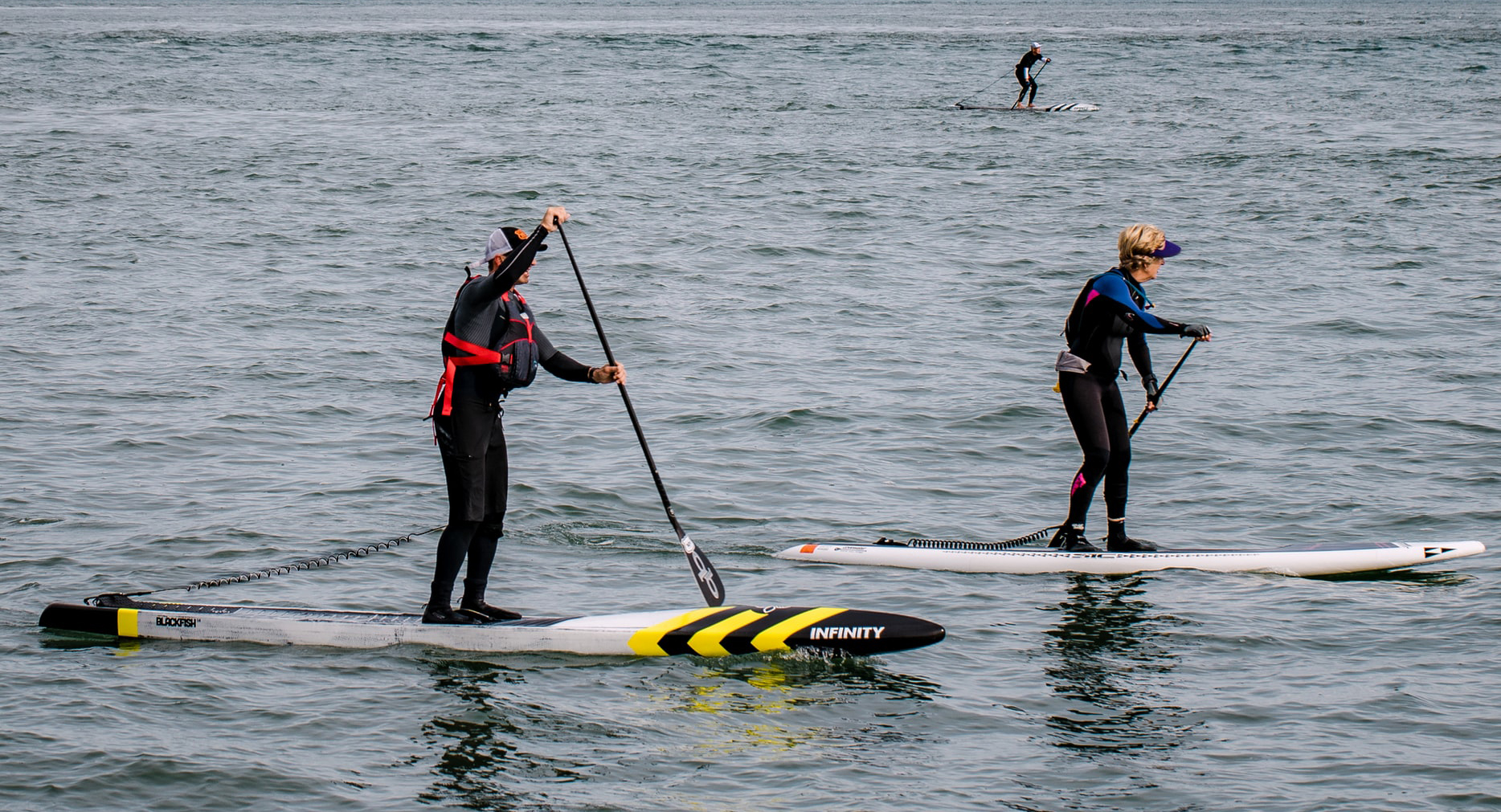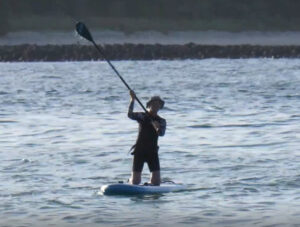All the essential SUP gear
Stand-up Paddleboarding is a fairly simple sport, equipment-wise. You need a board, a paddle, a leash, a buoyancy aid, some PPE and some comms. So So let’s go shopping…
Buoyancy aids
There are two primary reasons for a paddleboarder wanting a buoyancy aid. Firstly, a weak/non swimmer, will want that safety back-up for any and every time they fall in, which basically means something with built-in permanent buoyancy. There are some nice low-profile products which offer 50N of buoyancy, enough to give a bit of support and comfort, but not enough to keep someone afloat without effort for long periods of time. However, any product that does offer the full always-keep-you-afloat-face-up flotation is likely to be too big to be comfortable for extended paddling.
The competent swimmer and experienced paddleboarder who doesn’t need the backup of permanent flotation still needs to have a PFD – because it is the law!! The only exceptions to this are while actively involved in paddlesurfing, or in an organised competition if the race rules permit not wearing one. At all other times you need to have a PFD. (It doesn’t matter how close you are to the shore, or whether you are wearing a wetsuit or not).

For the competent paddler therefore, the belt-pack PFDs are the most low-profile and unobtrusive option. These PFDs are user-activated – when you need to deploy it, you pull the toggle, which auto-inflates the PFD from a CO2 cylinder. This is a very important point to understand – if you fall into the water unconscious, just wearing a belt-pack PFD will do nothing – you need to perform manual actions to turn the belt-pack into a functioning buoyancy aid.
For much more information on PFDs check out our web page all about them here, and better still, take a few hours to do our completely free SUP SAFE online course all about safety equipment, which will really help you make the right choices.
The leash
 A leash (also known as a legrope) to keep you attached to your board, is a vital part of paddleboarding safety. You should wear a leash at all times when on a SUP. Any suitable first-time board has massively more flotation than any life jacket could ever provide, and will keep you up and out of the water (even if you can’t stand up on the board for whatever reason), so by wearing a leash you have taken care of 90% of your safety planning right there. If your board doesn’t come with a leash, ask your retailer for one. Don’t try and improvise with a bit of rope or a roofrack strap!
A leash (also known as a legrope) to keep you attached to your board, is a vital part of paddleboarding safety. You should wear a leash at all times when on a SUP. Any suitable first-time board has massively more flotation than any life jacket could ever provide, and will keep you up and out of the water (even if you can’t stand up on the board for whatever reason), so by wearing a leash you have taken care of 90% of your safety planning right there. If your board doesn’t come with a leash, ask your retailer for one. Don’t try and improvise with a bit of rope or a roofrack strap!
So – you should always wear a leash. However, leashes come in a variety of sizes and styles, and it is very important to wear the right type of leash for the environment you will be paddling in. For general cruising, a short leash (down to 6′) is absolutely fine. Leashes incorporating some coil (either along the full length or just some of the length) means that the leash is not dragging in the water behind you, and not likely to catch on anything. However, coiled leashes are a real ‘marmite item’, people either love them or hate them. They do keep everything neat, but when they tangle they’re a right pain. They also spring the board back at you following a wipe-out. And they’re generally slightly more pricey. Probably wise to try before you buy.
For surfing it’s good to have a longer leash, so as to keep plenty of distance between you and your board if you’re getting tossed around in the surf. In surfing there is a general rule of thumb that the leash should be as long as the board, but many paddleboard surfers prefer not to go much longer than 8′, as too long a leash does increase your ‘kill radius’; the distance away from you which your board might travel, when picked up by a wave. Do not use a coiled leash in the surf, as it will cause the board to spring back at you after a wipeout!
Calf leashes attach around the leg just below the knee, which has the advantage of keeping the leash clear of the area beside the board where your paddle exits the water. Ankle leashes are generally considered better for the surf, as it’s a tighter fit and more comfortable.
A decent leash should be easy to take off in a hurry (ideally by simply yanking on a nice big pull tab), and many also have a key pocket, which is useful.
This getting-it-off-in-a-hurry factor becomes extremely significant if you are planning to paddleboard on fast-moving water, such as rivers. If you fall off in fast-flowing water you may well end up with your board on one side of a rock or other obstacle, and you on the other, unable to get out of your leash because of the force of the current. People have drowned this way. What you need for this environment is a quick-release White Water leash which is worn around the waist, with an easy-release pull toggle to undo it effortlessly in an emergency. (Purpose built kayaking lifejackets often have this quick-release system included as standard, and also offer some useful buoyancy and torso protection too!)
For much more information on leashes check out our web page all about them here, and better still, take a few hours to do our completely free SUP SAFE online course all about safety equipment, which will really help you make the right choices.
PPE
Not an acronym you were probably expecting to encounter in a SUP context, but it’s entirely accurate. Everything you wear when you’re paddleboarding has a protective role:
Clothing: In warm weather, if you’re not planning on falling off (and the water temperature is 15 degrees or more), then your clothing choices are largely going to be about keeping cool, and quite probably sun protection. Paddleboarding generates a lot of upper body heat, so wear layers that are easily removed so as not to end up over-heating out there!
 Wetsuits: If the water is cold, and/or you’re likely to be in it regularly (ie sup surfing), then a wetsuit may be an appropriate choice. But hopefully you’ll never be actually spending too long actually in the water (unless you forgot your leash!!). So a hardcore super-warm surfing or windsurfing/kitesurfing suit will probably be too warm – and also too restrictive. Bear in mind too that paddleboarding gets a whole different set of muscles pumped up compared to these other sports, so your perfectly-fitting surfing suit may actually end up feeling tight and uncomfortable. The rhythmic action of paddling can also generate chafe (or just a really annoying repetitive squeak!) around the arms and shoulders.
Wetsuits: If the water is cold, and/or you’re likely to be in it regularly (ie sup surfing), then a wetsuit may be an appropriate choice. But hopefully you’ll never be actually spending too long actually in the water (unless you forgot your leash!!). So a hardcore super-warm surfing or windsurfing/kitesurfing suit will probably be too warm – and also too restrictive. Bear in mind too that paddleboarding gets a whole different set of muscles pumped up compared to these other sports, so your perfectly-fitting surfing suit may actually end up feeling tight and uncomfortable. The rhythmic action of paddling can also generate chafe (or just a really annoying repetitive squeak!) around the arms and shoulders.
So ideally, you want something that will enable you to cope with occasional quick dunkings, but otherwise is as unrestrictive as possible, and not too hot or thick. For this reason many paddleboarders use relatively thin shorties or ‘long john’ (no arm) style suits. Thermal rash vests are also a very good option to consider, for the marginal days when a bit of protection makes sense but you really don’t need all the encumbrance of a wetsuit. Wind-chill is also likely to be much more of a factor when paddleboarding than surfing, which is why single-lined (‘smoothskin’ neoprene) is generally more efficient, as well as lighter.
Sun protection: Super important on the water, as you burn so much more easily. Using good waterproof suncream is good, but proper clothing (with a UPF factor of 50+) is smarter. A decent hat that protects your ears and neck is a really wise investment. And look after your eyes too, wear glasses that are fully UV-A and UV-B proof, and polarised too as it cuts down on the glare.
Foot protection: The vast majority of SUP injuries are to the feet, as it’s pretty much the only part of your body that is contact with the wider environment. Stepping down onto sharp rocks or shells is a common cause of cut feet, so if that’s the sort of environment you’re in, wear some decent footwear. If the water is cold, your feet will feel it, even if the rest of you is dry and toasty warm – treat yourself to some wetsuit boots.
For much more information on PPE for SUP, take a few hours to do our completely free SUP SAFE online course all about safety equipment, which will really help you make the right choices.
Comms
Being able to call for assistance while on the water is a really vital part of your SUP safety strategy, if you’re going any distance offshore or away from your starting point. Remember, it might not be you that’s in difficulties, you may well encounter someone else out on the water needing help!
Get a waterproof case for your mobile phone, and then you’re really well sorted – it also means you’ve got a camera and vid for those special moments, fitness tracking apps, music and more. If there is no signal in your area then consider a portable beacon (epirb) or a maritime VHF (ie with emergency Channel 16).
 The other really simple and smart bit of comms equipment to carry is a whistle. Small, simple and extremely effective. You’ve probably already got one with your PFD. Make sure you can get to it in an emergency.
The other really simple and smart bit of comms equipment to carry is a whistle. Small, simple and extremely effective. You’ve probably already got one with your PFD. Make sure you can get to it in an emergency.
Don’t forget also the good old-fashioned technique of simply waving your paddle. Wrap your rash vest around the blade to make it even more visible.
Whatever comms you carry, make sure they are on you, rather than on the board. Because losing your board would be a prime reason for needing to call for help!
For much more information on comms for SUP, take a few hours to do our completely free SUP SAFE online course all about safety equipment, which will really help you make the right choices.
Other things
Go into any decent paddleboard shop and you’ll find a whole plethora of other accessories on sale – wheels for your board, deckpads, various bags and holders, fishing accessories and much more. But they’re accessories, not essentials. At its heart, SUP is a very simple sport. Board, paddle. PFD and leash, and some sort of comms, and you’re good to go
